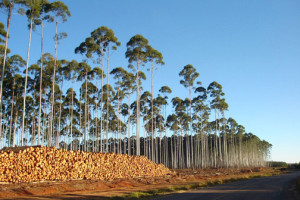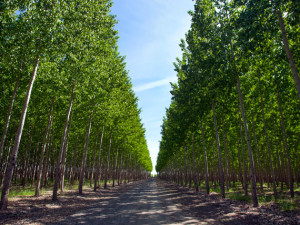
Approximately 80 percent of the woody biomass in a eucalyptus is made of cellulose and hemicellulose, both long chains of sugars, with the remaining biomass primarily comprised of lignin, the tough “glue” that holds it all together. (Image by H.D. Silva, Embrapa Forestry. Photo taken in Guarapava/PR.)
In honor of National Bioenergy Day, we thought we’d highlight some of our recent projects that are related to developing plant biomass, as well as agricultural waste and forestry byproducts, to generate heat and energy.
- Among the plants being considered for biomass crops are eucalyptus trees, which grow in 100 countries and cover over 40 million acres. Details about this project are at http://jgi.doe.gov/just-food-koalas-eucalyptus-global-tree-fuel-fiber/.
- The evolution of white rot fungi may have brought an end to the Carboniferous period, the 60-million year timeframe during which coal deposits were formed. Details about this study can be found at http://jgi.doe.gov/news_12_06_28/. Our collaborator David Hibbett of Clark University spoke about this project at one of our Genomics of Energy & Environment Meetings – watch his video on our Youtube channel.
- Enzymes from salt-tolerant microbes can help a class of solvents called ionic liquids more efficiently break down and enhance the sugar yields in biomass pretreatment technologies. Details at http://jgi.doe.gov/news_11_06_30/.
- Wood-decaying fungi may fall into more than 2 categories, which broadens the range of fungal decay strategies that can be explored for commercializing biofuels production. Details at http://jgi.doe.gov/treading-gray-area-along-spectrum-wood-decay-fungi/.
-

Poplar trees have the highest annual productivity of any hardwood species in North America. (DOE JGI)
Poplar plantations growing from California to British Columbia could help breeders determine which genotypes of the candidate biomass crop might thrive better than others in certain environments.Full details of the latest study at http://jgi.doe.gov/signatures-selection-inscribed-poplar-genomes/. Watch our colleague Jerry Tuskan of Oak Ridge National Laboratory talk about poplar plantations at http://bit.ly/Tuskan14fingerprints. Over the years, there have also been several presentations at our annual Genomics of Energy & Environment Meeting regarding work enabled by our sequencing of the poplar genome. Watch Jerry Tuskan give updates at http://bit.ly/JGIUM9_Tuskan and here. Watch ORNL’s Wellington Muchero at http://bit.ly/JGI7Muchero.